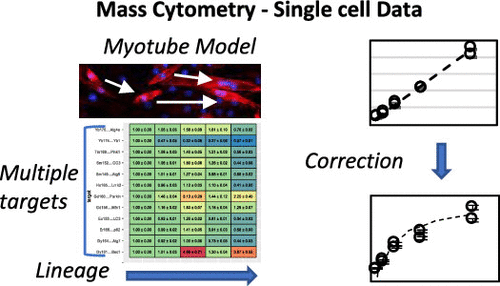当前位置:
X-MOL 学术
›
Anal. Chem.
›
论文详情
Our official English website, www.x-mol.net, welcomes your
feedback! (Note: you will need to create a separate account there.)
Nonspecific Binding Correction for Single-Cell Mass Cytometric Analysis of Autophagy and Myoblast Differentiation
Analytical Chemistry ( IF 6.7 ) Pub Date : 2020-12-22 , DOI: 10.1021/acs.analchem.0c03211 Heather M G Brown 1 , Michelle M Kuhns 1 , Zoe Maxwell 1 , Edgar A Arriaga 1
Analytical Chemistry ( IF 6.7 ) Pub Date : 2020-12-22 , DOI: 10.1021/acs.analchem.0c03211 Heather M G Brown 1 , Michelle M Kuhns 1 , Zoe Maxwell 1 , Edgar A Arriaga 1
Affiliation

|
Satellite cells provide regenerative capacity to the skeletal muscle after injury. In this process, termed myogenesis, satellite cells get activated, proliferate, and differentiate. Myogenesis is recapitulated in the tissue culture of myoblasts that differentiate by fusion and then by the formation of myotubes. Autophagy plays an important role in myogenesis, but the asynchronous and unique trajectory of differentiation of each myoblast along the myogenic lineage complicates teasing apart at what stages of differentiation autophagy plays a critical role. In this report, we describe a mass cytometric, multidimensional, individual cell analysis of differentiating myoblasts that characterizes autophagy flux (i.e., autophagy rate) at separate myogenesis stages. Because mass cytometry uses a set of lanthanide-tagged antibodies, each being specific for a desired molecular target, quantification of each molecular target could be exaggerated by nonspecific binding of its respective antibody to other nontarget cellular regions. In this report, we used lanthanide-tagged isotypes, which allowed for correction for nonspecific binding at the single-cell level. Using this approach, myoblasts were phenotypically identified by their position in the myogenic lineage, simultaneously with the quantification of autophagic flux in each identified subset. We found that generally autophagy flux is upregulated specifically during myoblast fusion and declines in myotubes. We also observed that mitophagy (i.e., selective autophagic degradation of mitochondria) is also active after myotube formation. The ability to track different types of autophagy is another feature of this methodology, which could be key to expand the current understanding of autophagy regulation in regenerating the skeletal muscle.
中文翻译:

自噬和成肌细胞分化的单细胞质量流式细胞仪分析的非特异性结合校正
卫星细胞在受伤后为骨骼肌提供再生能力。在这个称为肌生成的过程中,卫星细胞被激活、增殖和分化。肌发生在成肌细胞的组织培养中被概括,成肌细胞通过融合分化,然后通过肌管的形成。自噬在肌生成中起着重要作用,但是每个成肌细胞沿肌源谱系的异步和独特的分化轨迹使得区分自噬在哪些分化阶段起关键作用变得复杂。在本报告中,我们描述了分化成肌细胞的大规模细胞计数、多维、单个细胞分析,该分析表征了不同肌生成阶段的自噬通量(即自噬率)。因为质量流式细胞术使用一组镧系元素标记的抗体,每个分子靶标都对所需的分子靶标具有特异性,每个分子靶标的定量可以通过其各自抗体与其他非靶细胞区域的非特异性结合来夸大。在本报告中,我们使用了镧系元素标记的同种型,它允许在单细胞水平上校正非特异性结合。使用这种方法,成肌细胞通过其在肌源性谱系中的位置进行表型鉴定,同时量化每个已识别子集中的自噬通量。我们发现通常自噬通量在成肌细胞融合过程中特异性上调,而在肌管中则下降。我们还观察到线粒体自噬(即线粒体的选择性自噬降解)在肌管形成后也很活跃。追踪不同类型自噬的能力是该方法的另一个特点,
更新日期:2021-01-26
中文翻译:

自噬和成肌细胞分化的单细胞质量流式细胞仪分析的非特异性结合校正
卫星细胞在受伤后为骨骼肌提供再生能力。在这个称为肌生成的过程中,卫星细胞被激活、增殖和分化。肌发生在成肌细胞的组织培养中被概括,成肌细胞通过融合分化,然后通过肌管的形成。自噬在肌生成中起着重要作用,但是每个成肌细胞沿肌源谱系的异步和独特的分化轨迹使得区分自噬在哪些分化阶段起关键作用变得复杂。在本报告中,我们描述了分化成肌细胞的大规模细胞计数、多维、单个细胞分析,该分析表征了不同肌生成阶段的自噬通量(即自噬率)。因为质量流式细胞术使用一组镧系元素标记的抗体,每个分子靶标都对所需的分子靶标具有特异性,每个分子靶标的定量可以通过其各自抗体与其他非靶细胞区域的非特异性结合来夸大。在本报告中,我们使用了镧系元素标记的同种型,它允许在单细胞水平上校正非特异性结合。使用这种方法,成肌细胞通过其在肌源性谱系中的位置进行表型鉴定,同时量化每个已识别子集中的自噬通量。我们发现通常自噬通量在成肌细胞融合过程中特异性上调,而在肌管中则下降。我们还观察到线粒体自噬(即线粒体的选择性自噬降解)在肌管形成后也很活跃。追踪不同类型自噬的能力是该方法的另一个特点,











































 京公网安备 11010802027423号
京公网安备 11010802027423号